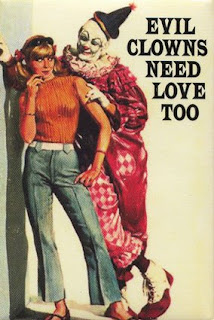What is the source of this poster's twisted concept?
A man has been assaulted by two men wearing clown masks in Donaghadee, a small town (population about 6,500) in County Down, Northern Ireland. The town lies on the northeast coast of the Ards Peninsula, about 18 miles (29 km) east of Belfast and about six miles (10 km) south east of Bangor.
At about 8 PM local time (2000 GMT) on Tuesday, 22 March 2011 (i.e. 22-3-11 in the UK), two men with baseball bats called to a flat in Barnagh Grove and assaulted the 42-year-old who lives there. The man's arm was broken and he suffered other injuries. He was taken to a hospital for treatment, according to the BBC.
Police said the attackers were wearing "clown-type masks" and black clothing.
Donaghadee is known as a significant site from the Irish Rebellion of 1798. On the morning of Pike Sunday, June 10, 1798, a force of United Irishmen (a guerilla force, not unlike the revolutionaries contemporary in America and France), mainly from Bangor, Donaghadee, Greyabbey and Ballywalter, Ireland, attempted to occupy the town of Newtownards. They met with musket fire from the market house and were defeated.
A question for the Irish readers: What is "Pike Sunday"?



2 comments:
Pike Sunday
In north-east Ulster, the home base of the Society of United Irishmen, the rising failed woeful.
At the time the rising had began in Dublin the leaders of the Ulster Provincial Council of the Society of United Irishmen were deposed. Motivated by the successes achieved in Wexford and urged by an angry message from Theobald Wolfe Tone Henry Joy McCracken and Henry Munro hurriedly made plans for a rising which became effective on 7 June in County Antrim.
Henry Joy McCracken signalled the beginning of the rising in County Antrim by hoisting the Green Flag on the market house in Ballymena. The rebels gained control over some smaller towns such as Larne, Glenarm, Carrickfergus, Toomebridge and Ballymoney, before they captured the county capital Antrim.
Their victory was granted only a short life. A few hours after the capture of Antrim the rebels were driven out by artillery fire. Disillusioned the rebel army in County Antrim disintegrated in the evening of 8 June. Some drifted home, while others, such as Roddy McCorley, went into hiding and formed gangs.
Under command of Henry Munro, a linen merchant without any military experience, the United Irishmen in County Down started to assemble on 10 June 1798, this day is known as Pike Sunday. About 12 miles from Belfast the rebels were defeated in the Battle of Ballynahinch on 12 and 13 June. Several hundred rebels and only three military died in this battle.
With the arrest and hanging of Henry Munro outside his own front door in Lisburn on 16 June the United Irishmen Rebellion in Ulster was over. Henry Joy McCracken was captured some weeks later and executed in Belfast on 17 July.
http://www.triskelle.eu/history/rebellionof1798.php
Bangor, Maine is the real-life town on which Derry, Maine is based in the classic modern evil-clown tale, "IT".
Post a Comment